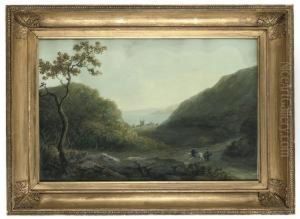Catherine Maria Bury Paintings
Catherine Maria Bury, née Baker, was a notable figure in the 18th and 19th centuries, not primarily for her contributions to the art world in the traditional sense, but for her role as a patron of the arts, her involvement in literary circles, and her own artistic endeavors, particularly in illustration and watercolor. Born in 1762, she was a part of the British aristocracy, which provided her the platform and the means to engage deeply with the cultural and intellectual movements of her time.
Catherine's marriage to Charles Bury, the 1st Earl of Charleville, further elevated her social standing, allowing her to establish a salon that became a hub for writers, artists, and intellectuals. This environment not only fostered her interests but also enabled her to commission works, thereby supporting the arts in a significant and impactful way. Her home became a meeting place for prominent figures of the Romantic era, including the likes of Robert Southey and William Wordsworth, indicating her influence in literary circles.
Despite not being widely recognized today for her own artistic output, Catherine Maria Bury's contributions to the arts during her lifetime were non-trivial. She was known to be a skilled illustrator and watercolorist, with her works often reflecting the natural beauty of the landscapes around her. These personal creations, however, were largely overshadowed by her role as a patron and her interactions with more publicly celebrated figures of the period.
Catherine Maria Bury's death in 1852 marked the end of an era. Her legacy, while not encapsulated in a vast body of artwork, lives on through the impact she had on the cultural and intellectual fabric of her time. Her life exemplifies the role of aristocratic women in the patronage and promotion of the arts during the Romantic period. Through her efforts, she not only nurtured the talents of the day but also contributed to the rich cultural heritage of Britain.
